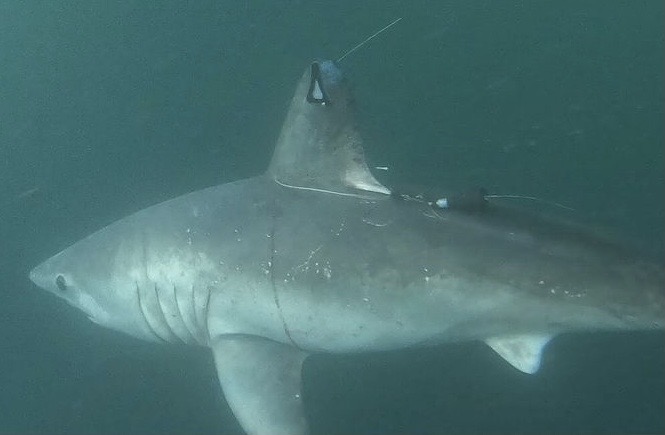Scientists Uncover Evidence of a Larger Shark Dining on a Smaller Shark
Posted on Categories Discover Magazine

Sometimes, it’s a shark-eat-shark world. Documented cases of larger sharks dining on smaller ones are relatively rare. Scientists have now found the first evidence of a larger species consuming the porbeagle shark, according to a report in Frontiers in Marine Science.
Porbeagles live in the Atlantic Ocean, the South Pacific Ocean and the Mediterranean Sea. They grow to around 12 feet and weigh up to about 500 pounds. Scientists started tracking a group of porbeagles in 2020 — not to see if they would end up as a food source, but to follow their migration route.
Tracking Shark Transmissions
Brooke Anderson, then a graduate student at Arizona State University, and colleagues captured porbeagles off Cape Cod in Massachusetts in 2020 and 2022. They attached two types of tags to each shark. One, mounted on the fin, only transmitted when it rose above the water’s surface. Another measured water depth and temperature.
One particular porbeagle was especially interesting, because she was pregnant. Female porbeagles don’t reproduce until they are about 13 years old, then give birth to an average four pups every year or two. Because of this relatively slow reproductive cycle, the porbeagle population cannot bounce back from loss as fast as other species.
The pregnant porbeagle’s fin-mounted tag began transmitting off Bermuda 158 days after her release. This implied that the tag had fallen off the shark and was floating on the ocean. Prior to that, it only broke the surface once. The other tag had sent a steady stream of data showing the shark was spending most of her time 200 feet to 300 feet underwater at night and much deeper during the day, experiencing water temperatures ranging from about 43 degrees Fahrenheit to 74 degrees Fahrenheit.
Read More: The Evolution of Sharks: What Were Ancient Sharks Like?
Sharks Eating Sharks
But suddenly, from March 24, 2021 onwards over four days, the temperature remained a steady 71.6 degrees Fahrenheit, and had sunk from about 500 feet to nearly 2,000 feet. The scientific team suspected that the shark was attacked and eaten, and the tag resumed transmission about four days later, after it was excreted.
Examples of sharks eating small sharks are relatively rare. But one featuring a creature of this size shows the porbeagle was particularly unlucky, while her predator was extremely fortunate.
“I think this was likely an opportunistic event,” says Anderson. “Keep in mind that the predation occurred about 300 meters deep in the open ocean, where high-value prey may be sporadic to find. In this scenario, a large pregnant porbeagle shark would be a lot of bang for your buck in terms of a meal.”
Read More: What Makes These 7 Shark Species Stand Out Among the Rest?
Advances in Satellite Tagging and Shark Research
While the scientists can’t say for sure what species ate the porbeagle, they have two likely suspects — the Great White and the Mako. Those are the only two shark species that live in that area and would be large enough to hunt and kill the porbeagle.
Even though this particular event marks a first in recorded shark predation, Anderson would not be surprised if more examples emerge in the coming years.
“It’s quite possible that with the development and advancement of satellite tagging technologies in recent decades that more novel behaviors like this are going to be revealed,” he says.
Searching for those behaviors won’t get any easier, though. Conservation efforts for many shark species call for the most minimally invasive research techniques. Video monitoring seems promising — but most sharks do their big-game hunting far off the coast, which would make retrieving a camera mounted on a tag difficult.
“Uncovering the mysteries of the open ocean has always been challenging,” says Anderson.
Read More: How Citizen Scientists Are Helping Sharks Around the World
Article Sources
Our writers at Discovermagazine.com use peer-reviewed studies and high-quality sources for our articles, and our editors review for scientific accuracy and editorial standards. Review the sources used below for this article:
Before joining Discover Magazine, Paul spent over 20 years as a science journalist, specializing in U.S. life science policy and global scientific career issues. He began his career in newspapers, but switched to scientific magazines. His work has appeared in publications including Science News, Science, Nature, and Scientific American.